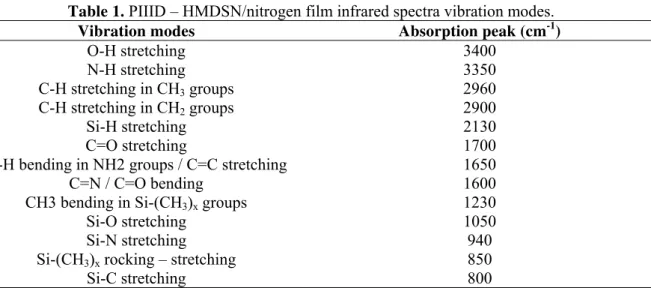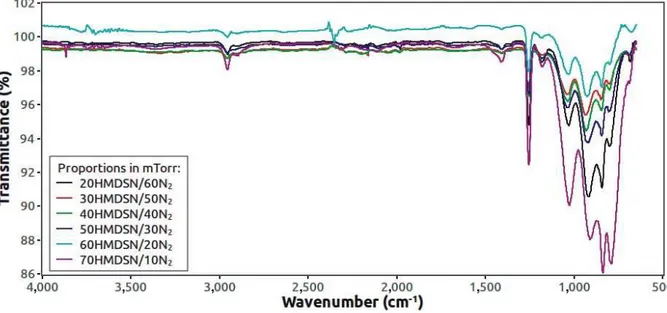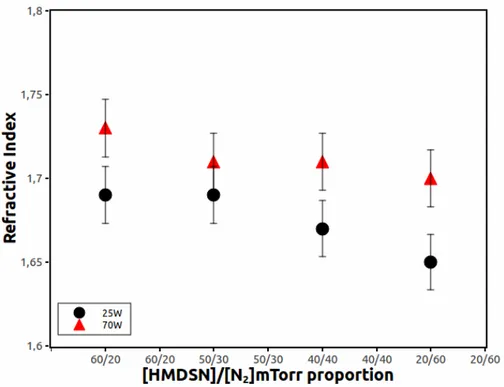Thin films generated by plasma immersion ion implantation and deposition of
hexamethyldisilazane mixed with nitrogen in different proportions
This article has been downloaded from IOPscience. Please scroll down to see the full text article.
2012 J. Phys.: Conf. Ser. 370 012028
(http://iopscience.iop.org/1742-6596/370/1/012028)
Download details:
IP Address: 200.145.3.40
The article was downloaded on 18/07/2013 at 21:14
Please note that terms and conditions apply.
Thin films generated by plasma immersion ion implantation
and deposition of hexamethyldisilazane mixed with nitrogen
in different proportions
F V P Kodaira1, R P Mota1, V A Hills1,2, R I Honda1, M E Kayama1, K G Kostov1 and M A Algatti1
1
UNESP – Campus Guaratinguetá, Av. Dr. Ariberto Pereira da Cunha, 333, 12516-410 – Guaratinguetá - SP, Brazil
2
School of Physics and Astronomy, The University of Nottingham, University Park, Nottingham, NG7 2RD, UK
E-mail: fevpk@yahoo.com.br
Abstract. In this work, it was used a plasma system composed of a cylindrical stainless steel reactor, a radio-frequency (13.56MHz) power source fixed at either 25 W or 70 W, a power source with a negative bias of 10kV and a 100Hz pulse. The system worked at an operational pressure of 80mTorr which consisted of varying concentrations of the monomer HMDSN and gaseous nitrogen in ratios: HMDSN (mTorr)/nitrogen (mTorr) from 70/10 to 20/60 in terms of operational pressure. The structural characterization of the films was done by FTIR spectroscopy. Absorptions were observed between 3500 cm-¹ to 3200 cm-¹, 3000 cm-¹ to 2900 cm-¹, 2500 cm-¹ to 2000 cm-¹, 1500 cm-¹ to 700 cm-¹, corresponding, respectively, to OH radicals, C-H stretching bonds in CH2 and CH3 molecules, C-N bonds, and finally, strain C-H bonds , Si-CH3 and Si-N groups, for both the 70 W and the 25 W.The contact angle for water was approximately 100° and the surface energy is near 25mJ/m² which represents a hydrophobic surface, measured by goniometric method. The aging of the film was also analyzed by measuring the contact angle over a period of time. The stabilization was observed after 4 weeks. The refractive index of these materials presents values from 1.73 to 1.65 measured by ultraviolet-visible technique.
1. Introduction
Material processing using low-temperature, low-pressure RF excited plasmas is essential in many current scientific and technological issues encompassing microelectronics, optical, electrical, biomaterial and others industries [1-12]. This feature of such plasmas gives rise to a very reactive chemistry in a relative cold environment whose kinetics is not easily controlled [13]. Plasma Immersion Ion Implantation & Deposition (PIIID) is a highly efficient technique for surface modification and thin film deposition. It can produce or modify metals, semiconductors and polymeric materials [14-18]. In this case, the materials are produced in a gas or vapor discharge and it is polarized simultaneously with high voltage pulses. Plasma ions are accelerated toward the films and implanted into their surfaces while the films are deposited.
13.56 MHz and polarized by pulses of negative 10 KV in 100 Hz. The samples were analyzed by infrared, uv-visible and goniometric techniques.
2. Experimental setup
The PIIID occurs inside a cylindrical stainless steel reactor 21.5 cm in diameter and 24.5 cm in height, with pipes to evacuation, controlled gas admission, and optical observation. Inside the reactor, there are two parallel stainless steel discs shaped plain electrodes with a gap of 3cm between them. The upper electrode is powered by a 13.56 MHz radiofrequency power source for the deposition; the lower one is fed by a 100 Hz and 10 kV high voltage power source for the ion implantation. In this lower electrode is where the glass and aluminum substrates are placed.
The system is initially evacuated by mechanical and turbomolecular vacuum pump, reaching the pressure of 10-5Torr, cleaning the system. After that, the turbomolecular pump is switched off and the mechanical pump keeps the system at 10-3 Torr. Then the HMDSN enters the reactor by a precise needle valve until it reaches the required pressure, so the nitrogen enters the same way and completes the pressure. The aim is to vary the proportion of the HMDSN and the nitrogen from 10mTorr to 10 mTorr so that the sum of them both is equal 80 mTorr in each deposition and try them all in both 25 W and 70 W of RF power for 20 minutes. The molecular structure of the samples was investigated by FTIR analysis using a Perkin Elmer Spectrum 100. The refractive index was measured by a Perkin Elmer Lambda 25 UV/VIS Spectrometer. The contact angle, surface energy and aging of the films were analyzed by a Hamé-Hart 300 – F1 equipment. The aging of the film was also analyzed in a period of 4 weeks.
3. Results and discussions
Figures 1 and 2 illustrate the infrared spectra of PIIID – HMDSN/Nitrogen films deposited at 70 W and 25 W radiofrequency power supply respectively. However, the HMDSN and nitrogen concentration was modified in each implantation/deposition process. The most important vibration modes of the molecular structure of these thin films are presented in table 1.
Table 1. PIIID – HMDSN/nitrogen film infrared spectra vibration modes.
Vibration modes Absorption peak (cm-1)
O-H stretching 3400
N-H stretching 3350
C-H stretching in CH3 groups 2960
C-H stretching in CH2 groups 2900
Si-H stretching 2130
C=O stretching 1700
N-H bending in NH2 groups / C=C stretching 1650
C=N / C=O bending 1600
CH3 bending in Si-(CH3)x groups 1230
Si-O stretching 1050
Si-N stretching 940
Si-(CH3)x rocking – stretching 850
Si-C stretching 800
For 70 W or 25 W PIIID, the same vibrational modes were observed in the samples, independently of the HMDSN-nitrogen concentration in the plasma, as shown in the figures 1 and 2. On the other hand, the intensity of the same bands like Si-(CH3)x, Si-O, Si-N in the range 1500-900 cm-1 was
changed. This implies that the chemical structure of the films was modified by PIIID process. Although the HMDSN does not contain oxygen, it was observed in the molecular structure of the films. It can be attributed to the atmospheric or residual oxygen present inside the reactor during PIIID process that reacts with the free radicals in the samples structure. Si-O and Si-H vibration modes in the 14th Latin American Workshop on Plasma Physics (LAWPP 2011) IOP Publishing Journal of Physics: Conference Series370(2012) 012028 doi:10.1088/1742-6596/370/1/012028
films are due to three concomitants effects of ion implantation processing: chain breakage, unsaturation and crosslinking. It is known that the impact of energetic ions with a target material causes chemical bond breakages and promotes emission of atomic and molecular species [19].
, , , , , , ,
Figure 1. IR spectra of HMDS/Nitrogen PIIID films at 70 W.
, , , , , , ,
Figure 2. IR spectra of HMDS/Nitrogen PIIID films at 25 W.
In polymeric materials, hydrogen bonds are preferentially lost because they belong to chain termination and hydrogen atom progressive emission induces the appearance of dangling bonds. The dangling bonds can recombine through unsaturation process such as double bond between carbon atoms or between carbon atoms and other species present in the polymeric structure.
Figure 3 shows the behavior of the refractive index of the films obtained at 70 W and 25 W. At 70 W the refractive index decreases form 1.73 to 1.70 while it decreases from 1.69 to 1.65 for the samples obtained at 25 W.
Figure 3. The refractive Index of the films obtained by PIIID at 70 W and 25 W in some different proportions of HMDS/Nitrogen.
This slight tendency in the behavior of the refractive index is the same in these cases, 70 W or 25 W. The PIIID process at 25 W produces films more colorless than at 70 W, which are slightly yellow. These alterations in the optical properties of the samples can be due to the random structure of the chains in a plasma polymer. Because the structures are random it makes theoretical interpretation of the experimental results rather difficult. However, it seems reasonable to suppose that some trends in the physical behavior of a “conventional” polymer must be followed by a HMDSN-Nitrogen PIIID polymer film. For example, the density of π bonds is influenced by the degree of hydrogenation that depends in turn on the applied power and different concentration of HMDSN and nitrogen in the PIIID process. The detachment of hydrogen, for example, from the polymer also affects bond lengths, thus changing the refractive index. In both cases (70 and 25 W) the films thicknesses decrease from 100 to 55nm while the concentration of nitrogen was higher than HMDSN. In the PIIID process nitrogen can contribute to make chemical bonds to form the film and it can promote ablation to destroy the polymer and so to reduce the film thickness.
Figures 4 and 5 present the contact angle and surface energy as a function of HMDSN and nitrogen concentrations at 70 and 25 W PIIID process respectively.
Independently of the HMDSN and Nitrogen concentration, in both cases of the PIIID process at 70 or 25 W, the contact angle and surface energy presented the same behavior with very close values. As the contact angle is near 100 degree, the samples present hydrophobic character and it was not changed after aging effect over the films. A representative aging effect can be observed in the figure 6. The films obtained in this work result of a competitive process of polymerization and ablation. As was discussed first, these films are formed mainly by free radicals within their structures and surfaces. So, rapid recombination of atoms and molecules involving oxygen contributed to create polar groups and 14th Latin American Workshop on Plasma Physics (LAWPP 2011) IOP Publishing Journal of Physics: Conference Series370(2012) 012028 doi:10.1088/1742-6596/370/1/012028
to saturate the surface bounds responsible for the hydrophobic character of the samples for a long time.
Figure 4. Contact angle and surface energy as a function of HMDSN and nitrogen concentration at 70 W PIIID process.
Figure 5. Contact angle and surface energy as a function of HMDSN and nitrogen concentration at 70 W PIIID process.
Figure 6. Aging effect represented by sample deposited at 60/20mTorr HMDSN/Nitrogen concentration at 25 W radiofrequency power.
4. Conclusions
The results of infrared measurements show groups not present in the mixture HMDSN-Nitrogen, but present in the films as a consequence of the PIIID to produce films with crosslinking structure and formed by free radicals.
The PIIID process is a competitive one characterized by polymerization and ablation simultaneously responsible of the formation of nanofilms that present hydrophobic character.
Acknowledgements
The Authors thank CNPq for financial support.
References
[1] d’Agostinho R, Favia P, Oehr C and Wertheimer M R 2005 Low-temperature plasma processing of materials: past, present and future Plasma Process. Polym. 2 7-15
[2] d’Agostinho R, Favia P, Kawai Y, Ikegami H, Sato N and Arefi-Kosari F 2008 (eds) Advanced Plasma Technology (Weinheim, Germany: Wiley-VCH)
[3] Hippler R, Kersten H, Schmidt M and Shoenbach K H 2008 (eds) Low Temperature Plasmas: Fundamentals, Technologies and Techniques (Weinheim, Germany: Wiley-VCH)
[4] Biederman H 2004 (ed) Plasma Polymer Films (London: Imperial College Press) [5] Bogaerts A, Neyts E, Gijbels R and van der Muller J 2002 Spectrochim. Acta B 57 609 [6] Chu P K, Chen J Y, Wang L P and Huang N 2002 Mat. Sci. Eng. Rep. 36 143-206
[7] Shul R J and Pearton S J 2000 (eds) Handbook of Advanced Plasma Processing Techniques (Berlin: Springer)
[8] Inagaki N 1996 Plasma Surface Modification and Plasma Polymerization (Technomic Publishing Company, Inc., USA)
[9] Roth J R 1995 Industrial Plasma Engineering: Principles v.1 (UK: IOP Publishing) [10] Roth J R 2001 Industrial Plasma Engineering: Applications v.2 (UK: IOP Publishing)
[11] d’Agostino R 1990 (ed.) Plasma Deposition, Treatment and Etching of Polymers, (New York: Academic Press)
[12] d’Agostino R, Favia P and Fracassi F 1997 (eds.) Plasma Processing of Polymers, NATO ASI series E: Applied Sciences vol 346 (Dordrecht, The Netherlands: Kluwer Academic Publishers)
[13] Yasuda H 1985 Plasma Polymerization (New York: Academic Press, Inc.)
14th Latin American Workshop on Plasma Physics (LAWPP 2011) IOP Publishing Journal of Physics: Conference Series370(2012) 012028 doi:10.1088/1742-6596/370/1/012028
[14] Poon R W Y, Ho J P Y, Liu X, Chung C Y, Chu P K, Yeung K W K, Lu W W and Cheung M C 2005 Improvements of anti-corrosion and mechanical properties of NITi orthopedic materials by acetylene, nitrogen and oxygen plasma immersion ion implantation Nucl. Instrum. Meth. B 237 411
[15] Fu R K Y, Cheung I T L, Mei Y F, Shek C H, Siu G G, Chu P K, Yang W M, Leng Y X, Huang Y X, Tian X B and Yang S Q 2005 Surface modification of polymeric materials by plasma immersion ion implantation Nucl. Instrum. Meth. B 237 417
[16] Gan B K, Bilek M M M, Kondyurin A, Mizuno K and McKenzie D R 2006 Etching and structural changes in nitrogen plasma immersion ion implanted polystirene films Nucl. Instrum. Meth. B 247 254
[17] Sui J and Cai W 2006 Mechanical Properties and anti-corrosion behavior of the diamond-like carbon films Surf. Coat. Tech. 201 1323
[18] Yeung K W K, Chan Y L, Lam K O, Liu X M, Wu S L, Liu K Y, Chung C Y, Lu W W, Chan D, Luk K D K, Chu P K and Cheung K M C, 2008 New plasma surface-treated memory alloys: towards a new generation of “smart” Orthopedic Materials Mat. Sci. Eng. C 28 454 [19] Santos D C R, Rangel R C C, Mota R P, Cruz N C, Schreiner W H and Rangel E C 2004
Modification of plasma polymer films by ion implantation Mater. Res. 7-3 493




